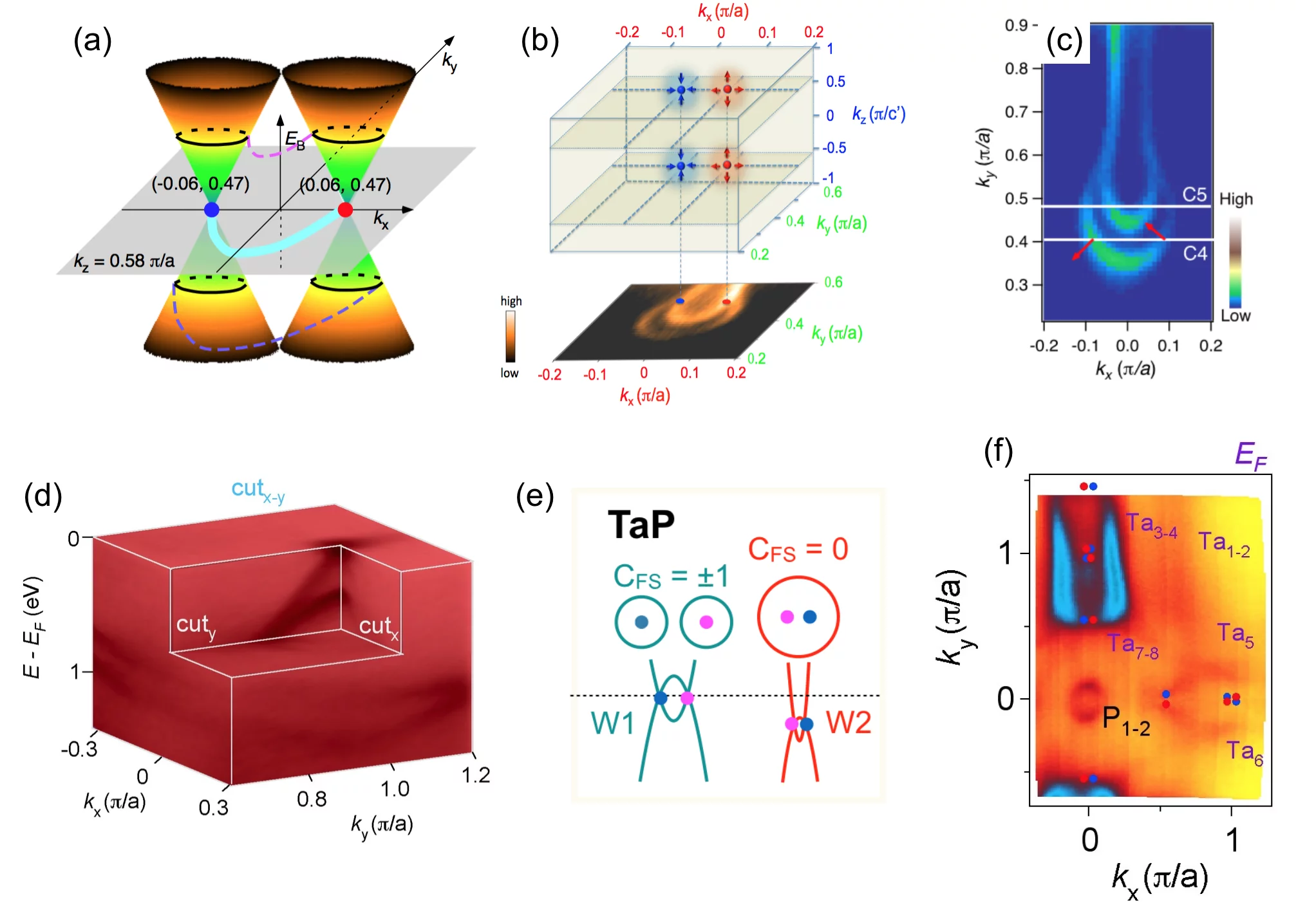Topological quantum matter is a new class of materials which are featured by global topological properties induced by purely local degrees of freedom. Using angle-resolved photoemission spectroscopy (ARPES) and related experimental probes, we are aimed to determine the electronic structures of promising topological quantum matter candidates and ascertain their topological properties.
Topological Kondo Insulator: Topological States can be hosted in correlated electron systems such as Kondo Insulators. By combining high energy-momentum resolution ARPES and spin-resolved ARPES technique, we probed the surface electronic structure of one of the most promising topological Kondo insulator candidate: SmB6 [1]. We observed that the bulk electronic structure of SmB6 opens a Kondo gap of 20 meV and identify in-gap surface states forming three Fermi surface [2]. These in-gap states are suppressed as temperature is raised above 20 K and disappeared at T > 110 K [3]. The experimentally determined spin texture of the in-gap states with spin-momentum locking [4] is consistent with the first-principle predicted Fermi surface topology of a topological Kondo insulator phase in this material.
Also see media release from PSI: Insulator makes electrons move in an ordered way
Also see media release from EPFL: Spin-based electronics: New material successfully tested
Weyl semimetal: Weyl fermions are a new type of particles which are massless, travel with the speed of light and have well defined chirality. Although their existence as fundamental particles remains elusive until now, advances in topological quantum matter have provided an alternative way to realize Weyl fermions in condensed matter, the Weyl semimetal. In a Weyl semimetal, two spin non-degenerate bands in the three-dimensional momentum space cross near the Fermi energy (called Weyl nodes), and the low-energy excitations behave exactly as Weyl fermions.
We have directly observed the three-dimensional Weyl cone structure in solid, by performing soft-x-ray ARPES experiments on the inversion symmetry breaking system TaAs [5]. The projections of Weyl nodes are exactly located on the ending points of the surface Fermi arcs states. We also identified that TaP is the simplest Weyl semimetal realized until now in which only single type of Weyl fermions contribute to the transport anomaly [6]. The Fermi arc states on Ta-termination are also observed by VUV-ARPES experiments, for the first time [6]. The spin texture of Fermi arc states is also experimentally verified by spin-resolved ARPES measurements [7].
Also see media release from PSI: New particle could form the basis of energy-saving electronics
Also see media release from PSI: Electron's cousin discovered after eighty-six-year search
References:
[1] Review article: N. Xu, H. Ding, Ming Shi, Spin- and angle-resolved photoemission on the topological Kondo Insulator candidate: SmB6. J. Phys.: Condens. Matter, 28, 363001 (2016).
[2] N. Xu et. al., Surface and bulk electronic structure of the strongly correlated system SmB6 and implications for a topological Kondo insulator. Phys. Rev. B 88, 121102(R) (2013). Editors’ suggestions.
[3] N. Xu et. al., Exotic Kondo crossover in a wide temperature region in the topological Kondo insulator SmB6 revealed by high-resolution ARPES. Phys. Rev. B 90, 085148 (2014).
[4] N. Xu et. al., Direct observation of the spin texture in SmB6 as evidence of the topological Kondo insulator. Nature Communications 5, 4566 (2014).
[5] B. Q. Lv*, N. Xu*, H. M. Weng* et. al., Observation of Weyl nodes in TaAs. Nature Physics 11, 724-727 (2015).
[6] N. Xu et. al., Observation of Weyl nodes and Fermi arcs in TaP. Nature Communications 7, 11006 (2016).
[7] B. Q. Lv*, S. Muff*, T. Qian*, Z. D. Song*, Observation of Fermi-Arc Spin Texture in TaAs. Phys. Rev. Lett. 115, 217601 (2015).
Contact
Surface / Interface: Spectroscopy beamline
+41 56 310 23 93
ming.shi@psi.ch
Spectroscopy Beamline at SLS

